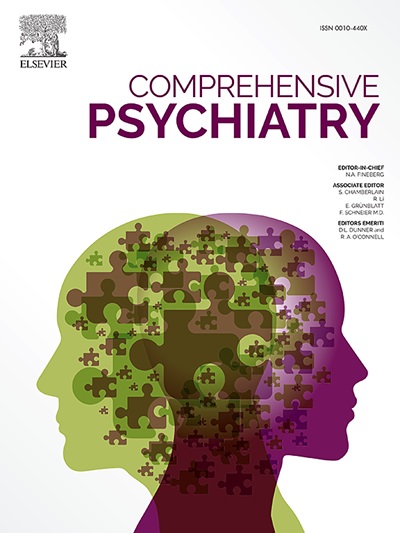Effect of stress on the relationship between relief-seeking and cue-induced alcohol craving and anxiety: A virtual reality cue exposure study
IF 4.2
2区 医学
Q1 PSYCHIATRY
引用次数: 0
Abstract
Objective
Stress is well-known to increase alcohol craving and alcohol cue-induced anxiety in individuals with alcohol use disorder (AUD). While previous research suggests that individuals who drink for relief experience strong alcohol cravings and associated anxiety, the interaction between stress and relief-seeking motives in predicting craving and anxiety responses to alcohol cues is not well understood. Using a virtual reality cue exposure paradigm, this study investigated the moderating role of stress on the relationship between relief-seeking motives and cue-induced alcohol craving and anxiety. We hypothesised that individuals with AUD who report high relief-seeking motives would show greater cue-induced craving and anxiety when exposed to a psychosocial stressor, compared to those not exposed to the stressor.
Method
Forty-nine participants were randomised into stress (n = 24) or no-stress (n = 25) exposure groups. Participants completed the Habit, Reward, and Fear Scale to measure drinking motives and visual analogue scales to measure cue-induced alcohol craving and anxiety. Heart rate and subjective stress were measured throughout the session.
Results
Stress moderated the relationship between relief-seeking motives and cue-induced alcohol craving (β = 1.90, p = .015); those with high relief-seeking motives exhibited greater cue-induced alcohol craving when stressed (β = 1.65, p = .011). Stress did not moderate the relationship between relief-seeking motives and cue-induced anxiety (β = 1.55, p = .148).
Conclusion
Individuals with high relief-seeking motives exhibit greater cue-induced alcohol craving when stressed, highlighting their increased vulnerability to harmful drinking and relapse, particularly during stressful situations. Further research is required to elucidate the cognitive-affective mechanisms of relief-driven drinking to inform more targeted interventions for these at-risk individuals.
压力对寻求缓解和线索诱导的酒精渴望与焦虑之间关系的影响:一项虚拟现实线索暴露研究
目的:众所周知,压力会增加酒精使用障碍(AUD)患者的酒精渴望和酒精线索诱发的焦虑。虽然之前的研究表明,为了缓解压力而喝酒的人会有强烈的酒精渴望和相关的焦虑,但压力和寻求缓解动机之间的相互作用,在预测酒精线索的渴望和焦虑反应方面,还没有得到很好的理解。本研究采用虚拟现实线索暴露范式,探讨了压力在寻求缓解动机与线索诱导的酒精渴望和焦虑之间的调节作用。我们假设,与未暴露于压力源的个体相比,报告高寻求缓解动机的AUD患者在暴露于社会心理压力源时表现出更大的线索诱导的渴望和焦虑。方法49例受试者随机分为应激组(n = 24)和无应激组(n = 25)。参与者完成了习惯、奖励和恐惧量表来衡量饮酒动机,以及视觉模拟量表来衡量线索引起的酒精渴望和焦虑。在整个过程中测量心率和主观压力。结果应激可调节缓解寻求动机与提示性酒精渴望的关系(β = 1.90, p = 0.015);那些有高度寻求缓解动机的人在压力下表现出更大的线索诱导的酒精渴望(β = 1.65, p = 0.011)。压力没有调节寻求救济动机和线索诱发焦虑之间的关系(β = 1.55, p = .148)。结论:具有高度寻求缓解动机的个体在压力下表现出更大的线索诱导的酒精渴望,突出了他们更容易有害饮酒和复发,特别是在压力情况下。需要进一步的研究来阐明缓解型饮酒的认知-情感机制,从而为这些高危人群提供更有针对性的干预措施。
本文章由计算机程序翻译,如有差异,请以英文原文为准。
求助全文
约1分钟内获得全文
求助全文
来源期刊

Comprehensive psychiatry
医学-精神病学
CiteScore
12.50
自引率
1.40%
发文量
64
审稿时长
29 days
期刊介绍:
"Comprehensive Psychiatry" is an open access, peer-reviewed journal dedicated to the field of psychiatry and mental health. Its primary mission is to share the latest advancements in knowledge to enhance patient care and deepen the understanding of mental illnesses. The journal is supported by a diverse team of international editors and peer reviewers, ensuring the publication of high-quality research with a strong focus on clinical relevance and the implications for psychopathology.
"Comprehensive Psychiatry" encourages authors to present their research in an accessible manner, facilitating engagement with clinicians, policymakers, and the broader public. By embracing an open access policy, the journal aims to maximize the global impact of its content, making it readily available to a wide audience and fostering scientific collaboration and public awareness beyond the traditional academic community. This approach is designed to promote a more inclusive and informed dialogue on mental health, contributing to the overall progress in the field.
 求助内容:
求助内容: 应助结果提醒方式:
应助结果提醒方式:


